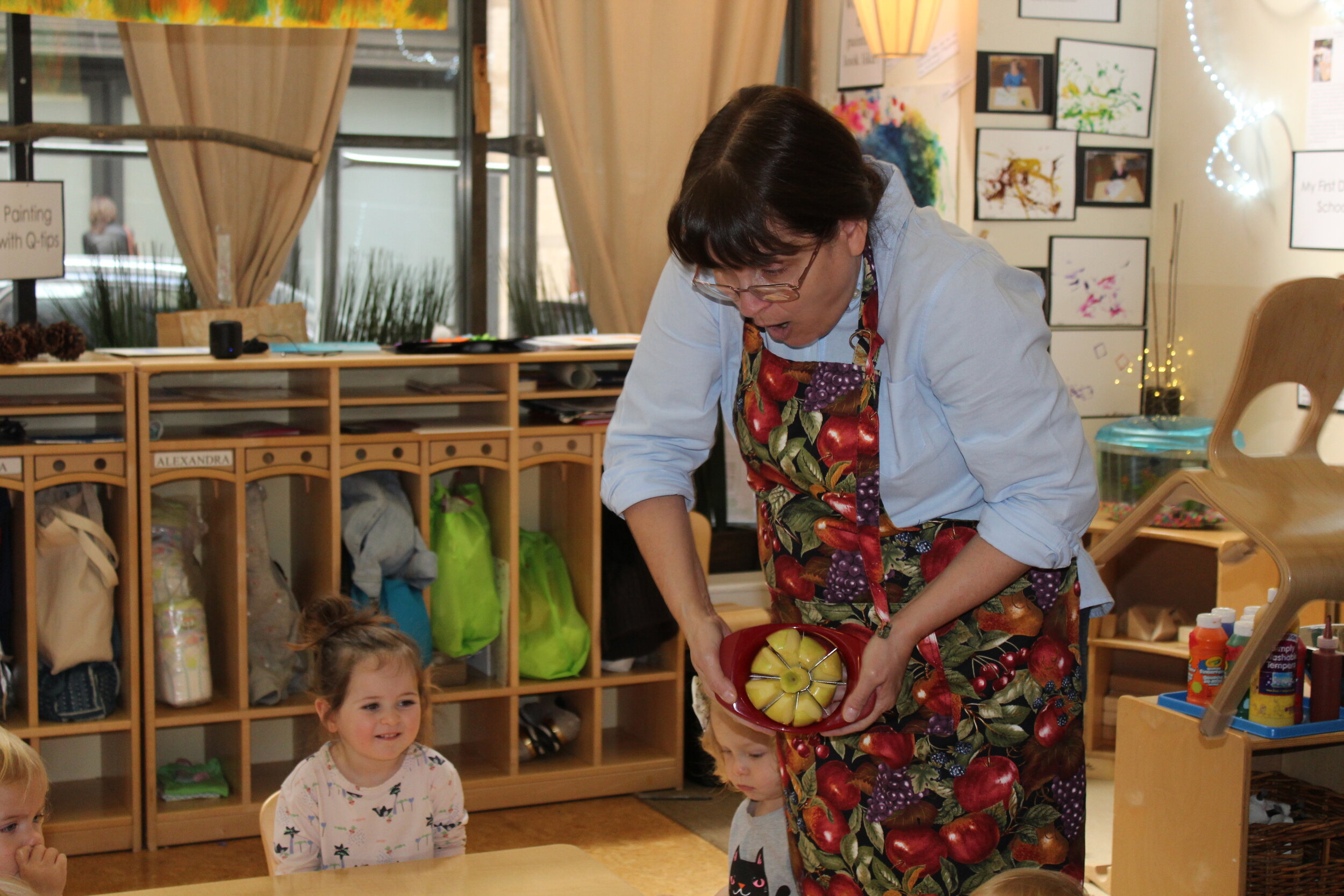
We sang and read a variety of books. We have also begun reading books about pumpkins and Halloween. If your child has a favorite book, please bring it to class and share with her peers.
Highlights of the Week:
Dentist Visit

Dr. Nicole Lambert came for a visit. They talked to the children about the importance of brushing their teeth and how to brush. Each child had a turn brushing the dragon's teeth.






Oobleck







The teacher asked, “How many drops of watercolor, I should add to the oobleck?”
Annabelle: "A lot!"
Teacher: "How much is a lot!"
Annabelle: "Many!"
Teacher: "Let all count ten drops!"

Oobleck incorporates both science and sensory exploration. It is a substance that's somewhere between a liquid and a solid. It pours like a liquid but acts like a solid when you squeeze it. Spoons were available for the children to extend their exploration. Watercolor was added to give it a vivid appearance.
The children looked intrigued in exploring the properties. They slowly dropped their hands into the oobleck, feeling, and squeezing its texture. They raised their arms and slowly opened their hands, allowing the oobleck to drip from their hands. They also moved his fingers through the mixture slowly and then tried moving their fingers fast. They noticed that they had to apply more strength and movement to scoop some oobleck. The stimulus prompted a calm and soothing disposition, as some of the children explored.






Annabelle appeared interested and curious as she observed the oobleck slowly dripping from her hand and fingers.



Painting

Toddlers love to explore with their senses. They enjoy the process of studying art materials and other sensory activities. Toddlers need time and freedom to be curious and creative and letting them explore and experiment with different objects and raw materials without any end goals to restrict them. For example, sand, water, chalk, paint, or play dough, children’s imaginations can run wild, and they can spend a long time exploring these, making their discoveries, stimulating their curiosity and developing their knowledge. Teagan worked there for quite some time exploring the paint and stamping her feet on the easel.


Painting on black paper, orange paint mixed with glue, and orange and black glitter, elicited the children's curiosity. Children form many connections and ideas of how the painting process works for them, as well as what they enjoy about it. Watch a child painting, and you will see a fully engaged child. We can almost see children’s thoughts, such as, " My handprints!
While we listen and observe, we may begin to understand the way a child perceives his/her world, his developmental abilities, and his needs or interests. The soothing process of painting seems what is interesting to young children. The pleasant feeling of painting over and over, possibly using two brushes or their fingers and hands, is what is essential. We need to encourage the experience where it interests the child. As children develop, they become more focused on creating representations and conveying ideas.

Ophelia: “I painting my fingers!”


Teagan: “My handprints!”


Teacher: “What are you doing?”
Annabelle: “I’m painting my hand, fingers, arms!”


As children paint with materials different from paintbrushes, they create magnificent work of art. Ideas and thoughts are processed and imagined while they explore.
They used the top portion of recycled plastic bottles to paint, and as they painted, they noticed circle shapes on their paper. Some overlapped, while others were isolated.

Sensory


As Annabelle engaged in play dough, she used a cookie cutter shaped like a star. She pushed and lifted the cookie cutter and yelled, "Star!" She began to sing Twinkle Twinkle Little Star as she manipulated the play dough.



Providing popsicle sticks, cookie cutters, and cups, for example, elicit curiosity and enables them to use their imagination as they interact with the material. As they squish, squash, roll, flatten play dough, they develop muscle tone.
Alexandra: “Heart, heart!”

Clay has so many endless possibilities and can be a beneficial indicator of children’s level of development in manipulative skills, confidence, vocabulary, concentration, and imagination.

Ophelia always used the Popsicle Sticks to make small indentations. However, today, she shredded the clay and counted some of the pieces.
Ophelia: "One, two, three." She stopped counting and continued shredding. Manipulating clay, in different ways, promotes new ideas and techniques as they explore.


Alexandra: “Look, cutting!”

Teagan created a birthday cake and used Popsicle Sticks as candles.
Teagan: “Happy birthday, to Teagan!”
Blocks

Infantino sensory blocks are put together, and pull and apart encourages imagination. The children can stack up and build sideways. The colors and the exciting texture promote them to maneuver, press, select the color, and create a structure.



Circle Time


Circle time is an essential daily activity in the preschool program. Children listen to a story, learn who is present and absent, discuss the daily schedule, find out about new materials in the classroom, and the activities they will be doing that morning. They sing songs or do a movement activity. The children enjoy listening and singing the song Row, Row, Row your Boat. They worked together to create the movements of the boat, as they sang.




Pumpkins and gourds are great resources for learning. Children need experiences with nature items, which will encourage their interests and curiosity. One of the parents brought in two unique shape gourds. The children appeared intrigued by the shapes, colors, and weight. The words, orange, green, heavy, were articulated as they explored. We also explored pinecones, and as they explored them, they used their sense of touch, sight, and smell. Circle time, children have opportunities to share their thoughts and ideas in a safe, encouraging environment. They begin to learn that they are valued and vital members of the group.









Children can develop an understanding of math throughout their daily routines, activities, and everyday interactions. For example, counting how many children attended school, counting ducks, frogs, and monkeys as they sing songs. During circle time, the teacher introduced different shapes using the unit blocks and the classroom environment. Words like round and circle were articulated to the children when pointing to the fan and clock. The tables in which they have snacks, lunch, and activities, has a square shape. Implementing math in a fun way and relating it to their surroundings, enables them to formulate an understanding of how math works.


Science Experiment

We did a science experiment using whole milk, dishwashing detergent, and food coloring. Below are some questions I asked the children:
1. What is this?
Teagan: "Milk!"
2. What color is the milk?
Teagan and Ophelia together: "White!"
3. What is the first color I am going to use?
Alexandra: yelled, "Red!"
4. What is the next color!
Teagan: "Purple!"





The next part of the experiment, the teacher, dipped the tip of a cotton swab into the dishwashing detergent and gave one to each child. With guidance, they gently touched the surface of the milk with the cotton swab. The colors burst! The children looked curious, surprised, and interested as they saw the colors move swiftly in different directions.





As the paint spread, Alexandra said, “A star!”

They all appeared excited and intrigued as they see the different colors erupt. The dishwashing detergent has a specific component that helps break the fat from greasy pots. Similarly, that is what is happening with milk. Milk contains fat; therefore, when the dishwashing detergent and milk are in contact, the molecules from both elements react and cause the colors to move.








The air was crisp, and the wind was blowing. A great day for a neighborhood stroll and buy our classroom Pumpkin. “There are so many pumpkins which one should we choose?" We found a perfect pumpkin and four mini pumpkins!



Specialists

Cooking with Diane
Classroom 1A will be joining us for Cooking with Diane, Spanish, and Music.

This week Diane shared with the children Apples and Apple Butter. Some of the children seemed to enjoy dipping the apples into the apple butter. Whereas, others preferred not to. Children have the option to taste or participate with Diane in making a meal. Children need to feel comfortable as they observe and engage.








Spanish

We welcome Beysi, as our Spanish Specialist for this week. Ernestina will officially return with us next week, as our Spanish specialist. During Spanish, everyone sang and danced to familiar songs, Buenos Dias, Si Estas Feliz, and Hasta Manana. She used puppets, and displayed cue cards as she sang. The children seemed to enjoy singing and dancing to the songs!





Soccer


Soccer benefits children's overall development. Playing soccer is an excellent exercise that improves cardiovascular health, increases coordination, improves strength, and enhances flexibility. It will also boost self-confidence and self-esteem.






Coach C. demonstrated a few techniques using their foot. The seemed to have enjoyed their first day at soccer.






Music



